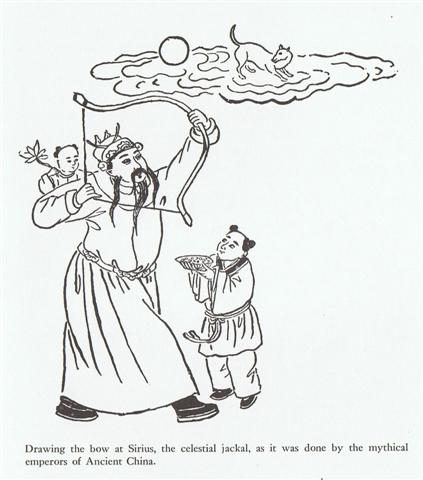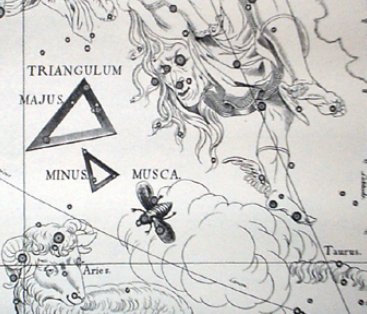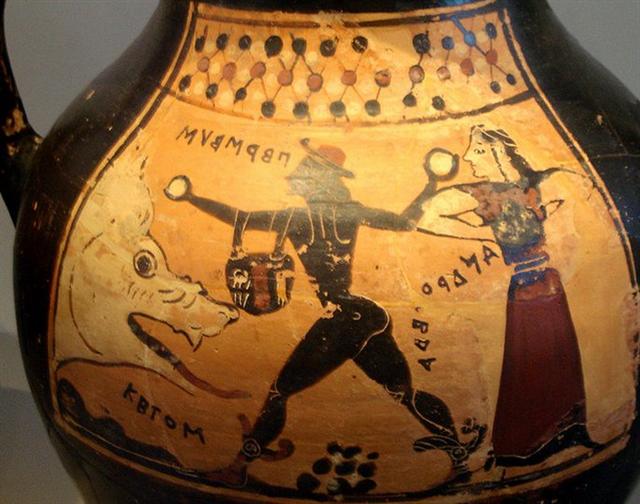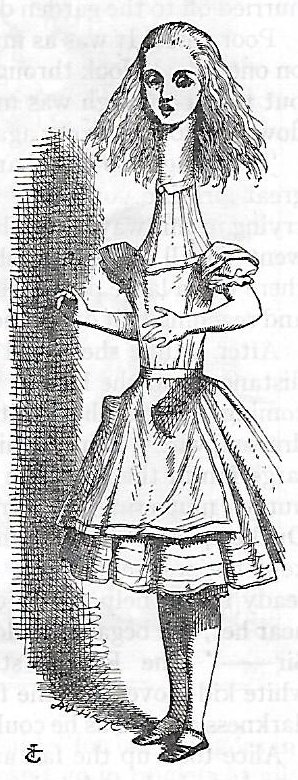117. Mebsuta was rising together with the Sun in June 29 - i.e. in the day before Sirius (Te Pou):
 At that time of the year it would be high summer in the northern hemisphere and therefore high up in the north the heliacal star observations would not be possible. But if Mebsuta was looked for in the evening (at 21h) of April 14 AD 2023 then this star at the Knee of Castor would - according to Cartes du Ciel - be observed precisely at the current place for the planet Mars. 21h is here the diurnal time to be counted from midnight and not from 0h: ... Allen has documented all his star culminations at 21h, which could be due to an effort of keeping the culminations at their proper places according to the ancients, 24h (spring equinox) - 21h = 3h = 24h / 8 = 45º. 3h corresponds to 366 / 8 = 45.75 of my right ascension days and *366 - *46 = *320 (Dramasa, σ Octantis) ... I have not listed the date for the culmination of Mebsuta, but Castor (*113) culminated in February 23 (which date in Roman times was named Terminalia, the End station). Therefore the culmination of Mebsuta should be around February 10 (31 + 10 = 41), *113 - *100 ↔ 23 - 10): This day, number 41 counted from January 1, suggests a similarity with 41 Arietis, i.e. Bharani (the Bearer), positioned at May 1 (121, *41), i.e. at Beltane (the beginning of summer), and a part of the asterism named the Northern Fly, Musca Borealis
... Anciently numbers were never chosen haphazardly, it was a serious business, and close to Mars in the night of November 6 AD 2022 we can find 121 Tauri (→ Beltane):
Toko. The higher-ranked of the two largest political units on Rapa Nui was the Ko Tu'u Aro Ko Te Mata Nui. This literally translates as The Mast/Pillar/Post Before the Greater Tribes. Toko te rangi, or Sky Propper, is named by Métraux in his corrected Miru genealogy as the thirteenth king of Easter Island and as one of the lineages or subgroups of the Miru. Although we have no record of the Sky Propper legend on Rapa Nui, other Polynesian legends of the Sky Propper are widely known, and they are formative elements in the basic cosmogenic theory of Polynesian belief. Sky (rangi) and Earth (papa) lay in primal embrace, and in the cramped, dark space between them procreated and gave birth to the gods such as Tane, Rongo and Tu. Just as children fought sleep in the stifling darkness of a hare paenga, the gods grew restless between their parents and longed for light and air. The herculean achievement of forcing Sky to separate from Earth was variously performed by Tane in New Zealand and the Society Islands, by Tonofiti in the Marquesas and by Ru (Tu) in Cook Islands. After the sky was raised high above the earth, props or poles were erected between them and light entered, dispelling the darkness and bringing renewed life. One detail which is iconographically of interest is whether the god responsible for separating Earth and Sky did so by raising the Sky with his upraised arms and hands, as in Tahiti and elsewhere, or with his feet as in New Zealand. The actual props, pillars or posts which separated the sky and earth are called toko in New Zealand, to'o in the Marquesas Islands and pou in Tahiti. In Rapanui tuu and pou are known, with pou meaning column, pillar or post of either stone or wood. Sometimes the word is applied to a natural rock formation with postlike qualities which serves as an orientation point. The star Sirius is called Te Pou in Rapanui and functions in the same way. One monolithic basalt statue is called Pou Hakanononga, a somewhat obscure and probably late name thought to mean that the statue served to mark an offshore tuna fishing site. The Rapanui word tokotoko means pole or staff. Sacred ceremonial staves, such as the ua on Rapa Nui, were called toko in Polynesia. Based upon the fact that toko in New Zealand also means 'rays of light', it has been suggested that the original props which separated and held apart Sky and Earth were conceived of as shafts of dawn sunlight. In most Polynesian languages the human and animate classifier is toko-, suggesting a congruence of semantic and symbolic meaning between anthropomorphic form and pole or post. Tane as First Man and the embodiment of sunlight thus becomes, in the form of a carved human male figure, the probable inspiration for the moai as sacred prop between Sky and Earth. The moai as Sky Propper would have elevated Sky and held it separate from Earth, balancing it only upon his sacred head. This action allowed the light to enter the world and made the land fertile. Increasing the height of the statues, as the Rapa Nui clearly did over time, would symbolically increase the space between Sky and Earth, ensuring increased fertility and the greater production of food. The proliferating image, consciously or unconsciously, must have visually (and reassuringly) filled the dangerously empty horizon between sea and land, just as the trees they were so inexorably felling once had. (Van Tilburg) Tokotoko, stick, cane, crutches, axe helve, roller, pole, staff. P Pau.: tokotoko, walking stick. Mgv.: toko, a pole, stilts, staff. Mq.: tokotoko, toótoó, stick, cane, staff. Ta.: too, id. Churchill.
... The ultimate proof is out there to see for yourself. But insight requires an internalized map - based on the outside world. How can one convince someone who does not possess such a corresponding map? And coversely, how can I be sure that I have aquired the map described by others? I think the intention of Stretching Out the body of Alice, as if she was changing into a Tree,
was meant to allude to the star named Outstretched (Mebsuta), rising with the Sun in day number 180. This idea needs support from the text, and indeed we can find such: "CHAPTER II The Pool of Tears 'CURIOUSER and curiouser!' cried Alice (she was so much surprised, that for the moment she quite forgot how to speak good English), 'Now, I'm opening out like the largest telescope that ever was! Good-bye, feet!' (for when she looked down at her feet, they seemed to be almost out of sight, they were getting so far off). 'Oh, my poor little feet, I wonder who will put on shoes and stockings for you now, dears? I'm sure I sha'n't be able! I shall be a great deal too far off to trouble myself about you: you must manage the best way you can - but I must be kind to them', thought Alice, 'or perhaps they wo'n't walk the way I want to go! Let me see, I'll give them a new pair of boots every Christmas,' And she went on planning to herself how she would manage it. 'They must go by the carrier,' she thought; 'and how funny it'll seem, sending presents to one's own feet! And how odd the directions will look! Alice's Right Foot, Esq. Hearthrug, near the Fender, (with Alice's love). Oh dear, what nonsense I'm talking!'" The Pool of Tears suggests the place of the Celestial Jackal, Sirius. ... According to an etiological Hawaiian myth, the breadfruit originated from the sacrifice of the war god Kū. After deciding to live secretly among mortals as a farmer, Ku married and had children. He and his family lived happily until a famine seized their island. When he could no longer bear to watch his children suffer, Ku told his wife that he could deliver them from starvation, but to do so he would have to leave them. Reluctantly, she agreed, and at her word, Ku descended into the ground right where he had stood until only the top of his head was visible. His family waited around the spot he had last been day and night, watering it with their tears until suddenly a small green shoot appeared where Ku had stood. Quickly, the shoot grew into a tall and leafy tree that was laden with heavy breadfruits that Ku's family and neighbors gratefully ate, joyfully saved from starvation ... ... 'From the time I was in your womb,' Maui went on, 'I have known the names of these children of yours. Listen,' he said as he pointed to his brothers in turn. 'You are Maui mua, you are Maui roto, you are Maui taha, and you are Maui pae. And as for me, I am Maui potiki, Maui-the-last-born. And here I am.' When he had finished, Taranga had to wipe her eyes because there were tears in them, and she said: 'You are indeed my lastborn son. You are the child of my old age. When I had you, no one knew, and what you have been saying is the truth. Well, as you were formed out of my topknot you can be Maui tikitiki a Taranga.' So that became his name, meaning Maui-formed-in-the-topknot-of-Taranga. And this is very strange, because women in those days did not have topknots. The topknot was the most sacred part of a person, and only men had them ... ... And in the morning Quetzalcoatl said, in shame, 'I have sinned; the stain of my name cannot be erased. I am not fit to rule this people. Let them build a habitation for me deep under the ground; let them bury my bright treasures in the earth; let them throw the glowing gold and shining stones into the Precious Waters where I take my nightly bath. And all this was done. The king remained four days in his underground tomb, and when he came forth he wept and told his people that the time had come for his departure to the Red Land, the Dark Land, the Land of Fire. Having burned his dwellings behind him, buried his treasures in the mountains, transformed his chocolate trees into mesquite, and commanded his multicolored birds to fly before him, Quetzalcoatl, in great sorrow, departed. Resting at a certain place along the way and looking back in the direction of Tula, his City of the Sun, he wept, and his tears went through a rock; he left in that place the mark of his sitting and the impress of his palms ...
|
|||||||||||||||||||||||||||||||||||||||||||||||||||||||||||||||||||||||||||||||||||||||||||||||||||||||||||||||||||||||||||||||||||||||||||||||||||||||||||||||||||||||||||||||||||||||||||||||||||||||||























